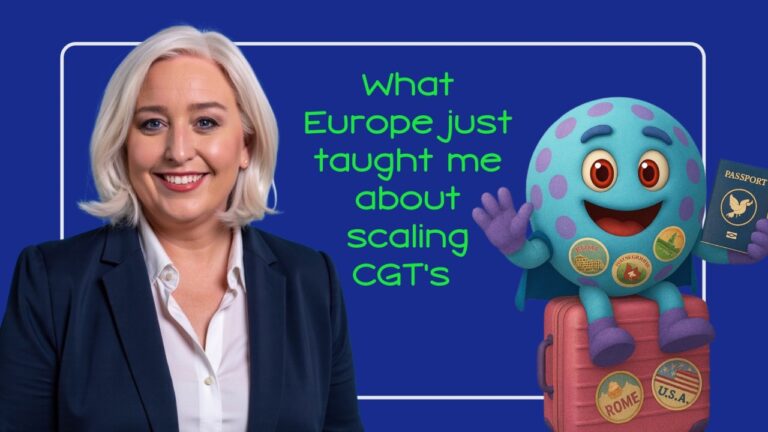Blueprint for Breakthroughs is a LinkedIn newsletter published by Adrienne B. Mendoza, MHA, SVP BioBridge Global and Chief Operating Officer (COO), BBG Advanced Therapies
Originally published on LinkedIn on September 12, 2025
I came to Barcelona to meet, share, and learn from colleagues who are fighting the good fight to bring cell and gene therapies to patients faster—and left convinced we’re closer to real answers than it might seem.
While many of the world’s largest pharma companies are Europe-headquartered, the U.S. still has more marketed therapies today. But Europe is catching up fast, with new approvals like CASGEVY and DURVEQTIX, and some models of innovation here are moving at a pace that rivals—or even surpasses—the U.S.
Common Struggles, Shared Spirit
The themes that kept surfacing were familiar: regulatory complexity, payer negotiations, infrastructure bottlenecks, and cost pressures. Europe adds another layer of complexity because EMA approvals must still navigate 27 national health systems. Yet, despite that, the determination I saw among leaders here is inspiring.
Are New Models the Answer?
There’s a lot of debate right now about whether decentralized models can really work in Europe, or beyond. In some places, leading academic medical centers are already delivering their own cell therapies end-to-end, without support from biopharma. In others, access depends heavily on which member state you live in and what resources are available. In either case, there are disparate, geographically specific models being created.
What is not debatable are the inequities and logistical hurdles baked into the current system:
- Patients in one country may have timely access, while those in another face years of delay.
- Some centers are resourced to handle collection, manufacturing, and delivery—others are not.
- Payer and reimbursement pathways vary widely across countries and even within districts in each country.
This creates a growing interest in different approaches across Europe, with some regions experimenting boldly. But there is no one-size-fits-all solution. Any progress will require us to revisit the entire ecosystem—political frameworks, regulatory processes, and delivery systems—and find a path to reduce complexity and smooth access.
The truth is, these issues are not unique to Europe. The U.S. faces tremendous inequities and bottlenecks, and many other countries are confronting similar questions. That makes this a global problem in need of global solutions.
Sharing the Mobile Leukapheresis Center Vision
Against that backdrop, I presented the Mobile Leukapheresis Center — designed to bring cell collection closer to patients and reduce the burden of travel to specialized sites.
In Texas in the US, it’s beginning to support our local community and is designed to expand the number of clinical sites able to participate in ATMP/CGT delivery. By taking on the cell collection step, mobile centers concentrate expertise which reduces cost and allows more clinical sites to be activated by letting them focus on the transfusion of finished products—a model consistent with routine drug delivery and blood transfusion that every health system understands.
This way, the downstream healthcare delivery system doesn’t need to take on the complex logistics and infrastructure required to collect and manage cells to make it to manufacturing facilities, often thousands of miles away. In doing so, mobile centers remove a barrier to access and make these therapies available to more patients.
The response in Europe was overwhelmingly positive. Leaders here immediately recognized how such a model could help navigate the continent’s divergent equities, where geography, capacity, and regulation often slow down access.
Creating a “Passport” for ATMPs and CGTs
If we want consistent access across borders, we need something more than parallel national systems. We need a trusted mechanism that cuts through fragmentation—a “passport” for advanced therapies.
There’s actually precedent. For decades, allogeneic stem cell transplantation has relied on shared accreditation frameworks like FACT, JACIE, AABB, and the Alliance for Harmonisation of Cellular Therapy Accreditation (AHCTA) that ensure trust, safety, and quality.
Together, these elements function as a passport for stem cells: once material is collected and accredited under agreed standards, it can be transported internationally and recognized for use in another country.
Imagine applying the same principle to ATMPs/CGTs. With harmonized accreditation and mutual recognition, a therapy approved or manufactured in one jurisdiction could move more smoothly into another—reducing duplication, accelerating delivery, and creating equity for patients regardless of their postcode.
A CGT passport would not replace national decision-making, but it could provide a common foundation of trust and quality—this could be part of what’s needed to unlock access at scale.
Drafting a Blueprint
What’s needed now is a blueprint for ATMP/CGT access—a framework that is consistent, flexible, and collaborative. It should:
- Place blood centers at the center, leveraging their global networks and logistics expertise in moving sensitive blood, tissue and cell products around the globe.
- Evolve harmonized accreditation into a CGT “passport,” reducing duplicative barriers and enabling mutual recognition across borders.
- Encourage cross-sector collaboration, uniting pharma, providers, payers, regulators, and logistics innovators.
- Stay flexible, adapting to local realities while holding to principles of equity and quality.
The Bridge We Must Build
Here’s my biggest takeaway: neither Europe nor the U.S. can do this alone.
- Europe is experimenting with new care and delivery models.
- The U.S. still has a broader commercial footprint.
- Both face affordability and equity challenges.
That’s why we need a true bridge between these continents and more — developers, manufacturers, payers, regulators, and solution providers like blood centers all working side by side.
Don’t Forget the Patients
It’s easy to get lost in frameworks, tariffs, and pricing debates. But what struck me most on this trip is the real impact these therapies are already having. Patients are walking around today who would not be without them. Families have hope where before there was none.
There are more waiting — We cannot let them down.
👉 If you’re working on new models—whether in biotech, healthcare delivery, blood services, or logistics—I’d love to hear how you’re tackling these challenges. Let’s learn from each other and co-create the blueprint that will last.
